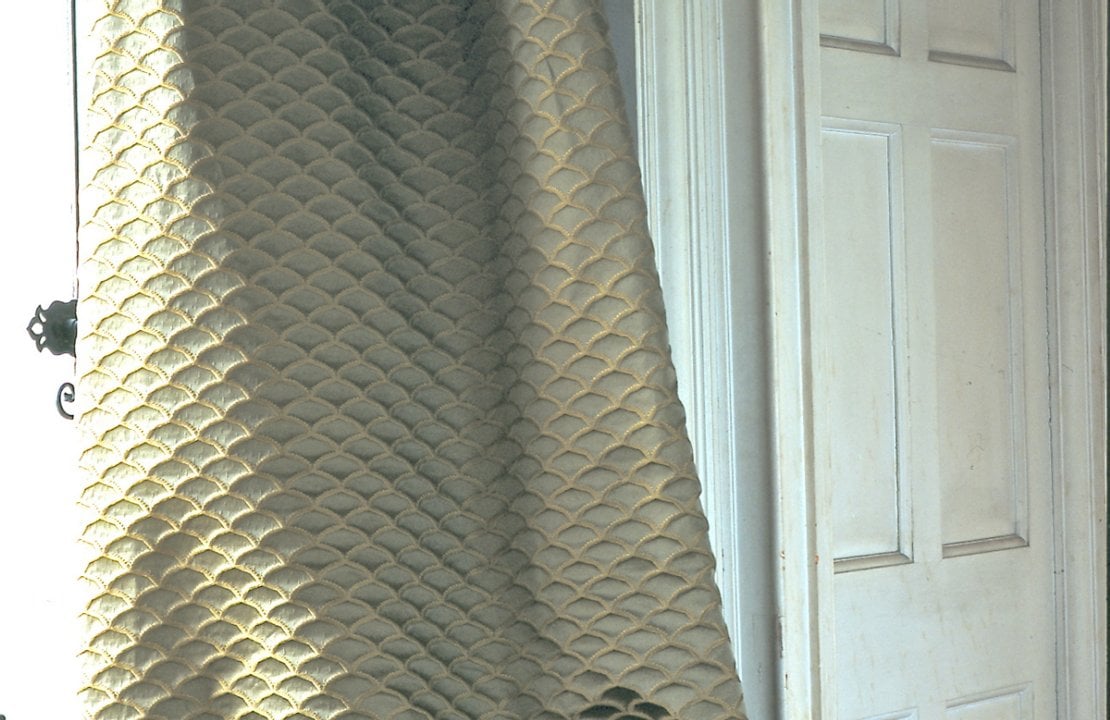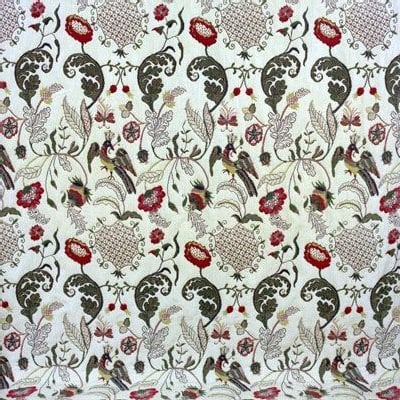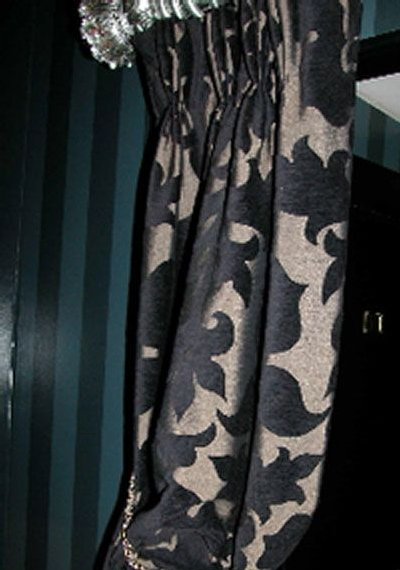Heavy curtains are really useful for large windows. However a general piece of advice when choosing curtain fabrics: for small windows, whilst the method of construction ie fabric/lining/interlining is identical, the pattern (if any) of the fabric will need to be scaled down accordingly. The standard convention, small room = small pattern; large room = large pattern, applies to windows as well as wallpaper.
There are many heavy curtain fabrics available to purchase – these tend to be more expensive than standard weight fabrics and with a high wool content, but should be seen as an investment as good quality curtains should last many years if not decades.
A perfect fabric for winter curtains from our collection is English Needlework composed of wool and cotton – the floral design of this fabric is delightful, and is typical of early 18th Century domestic needlework and adapted from a panel at Cothele.
The Victorian Emporium's English Needlework Fabric.
Some of the lighter weight wools are also suitable such as Small Falcons and Genoa wool damask. For a more luxurious finish and some sheen, a Magnus, Veronese or Versailles would all be good choices.
The Victorian Emporium's Veronese Fabric
Heavy curtains can be used as extra protection from the weather over front doors and give a cosy feel to entrance halls. For a truly sumptuous curtain (which would look good in a passageway) the main fabric could be a brocade and the lining in matching/contrasting velvet with fringes and tassels. This could be hung from a pole or accompanied with swags or a valance, both of which could also be suitably fringed. To be really draught proof these could be interlined with thermal lining however care must be given to the finished weight as the pole or curtain track must be very secure in order to bear the weight. If attaching a curtain like this to a door, a portiere rod (which rises as the door opens) is used.
How can you keep the cold weather out using curtains?
The Victorians used more than one set of curtains at a time and you can do the same. The multiple layers of window coverings used by the Victorians consisted usually of a blind next to the glass, with up to three separate sets of curtains in the main rooms of the house. Sub curtains of lace or sheer fabric, a middle set of lined curtains made of velvet or damask and a top pair made of a heavy material such as tapestry. The sub curtains were often made of Nottingham lace and were good for catching dirt as they were easier to wash and cheaper to replace than the other heavier layers of curtains. These four layers are probably overkill in today’s period properties, however it’s still a good idea to use a blind or set of sheer curtains under your heavy winter curtains for added insulation.
Interlining should be included in winter weight curtains which is perfect for the British climate. A good guide is to construct curtains with 260 gm. cotton twill domette interline with a medium heavy curtain fabric. If using a very heavy fabric such as English Needlework you may choose a lighter weight interline.
There are also thermal linings available, however it is preferable to use natural fibre interline with these thick fabrics. There doesn’t seem to be any advantage in using a man made lining material unless the face fabric is a cotton or linen and no interliner is being used.
There are added benefits of thick curtains for example they protect the contents of your room from direct sunlight and as such protect precious possessions from sunlight damage.
Double sided heavy curtains using either matching/contrasting linings are very attractive but best suited to a window that doesn't get full sun as any coloured lining/fabric will fade to some degree and some fabrics will 'bleach' fairly quickly. If the curtain is drawn back to a wall return during sunlight hours then this effect is obviously lessened.
Heavy curtains are traditionally weighted down along the hem with lead weights. This not only ensures the curtain hangs well but certainly in earlier years kept the curtains from blowing in the draught from "leaky" Victorian windows.
The Victorian Emporium sell a wide range of heavy curtain fabrics along with lighter weight fabrics and accessories to protect your house from the cold.




Posted by Verena - Oct 17, 2018 - 11:57
Wonderful website you have here but I was curious about if you knew of any message boards that cover the same topics
talked about in this article? I’d really like to be a part of online community where I can get comments from other experienced individuals that share the
same interest. If you have any suggestions, please let me know.
Kudos!
antagonisable (Latrice)